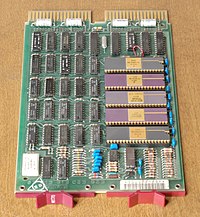
Photo from wikipedia
Low power consumption associated with data transmission and processing of wearable/implantable devices is crucial to ensure the usability of continuous health monitoring systems. In this paper, we propose a novel… Click to show full abstract
Low power consumption associated with data transmission and processing of wearable/implantable devices is crucial to ensure the usability of continuous health monitoring systems. In this paper, we propose a novel health monitoring framework where the signal acquired is compressed in a task-aware manner to preserve task-relevant information at the sensor end with a low computation cost. The resulting compressed signals can be transmitted with significantly lower bandwidth, analyzed directly without a dedicated reconstruction process, or reconstructed with high fidelity. Also, we propose a dedicated hardware architecture with sparse Booth encoding multiplication and the 1-D convolution pipeline for the task-aware compression and the analysis modules, respectively. Extensive experiments show that the proposed framework is accurate, with a seizure prediction accuracy of 89.70 % under a signal compression ratio of 1/16. The hardware architecture is implemented on an Alveo U250 FPGA board, achieving a power of 0.207 W at a clock frequency of 100 MHz.
Journal Title: IEEE Transactions on Biomedical Circuits and Systems
Year Published: 2023
Link to full text (if available)
Share on Social Media: Sign Up to like & get
recommendations!